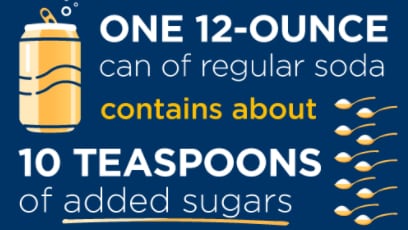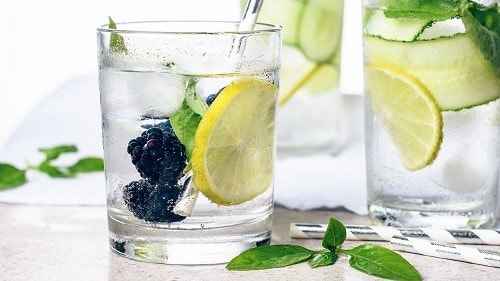What to know
Sugary drinks are the leading source of added sugars in the American diet. People who often drink sugary drinks are more likely to experience health problems. These problems include weight gain, obesity, type 2 diabetes, heart disease, cavities, and gout, a type of arthritis. Learn how to rethink your drink.

Sugar and calories in common drinks
The next time you go grocery shopping, read the nutrition labels on the items in your cart to see which ones have the most added sugars. You may be surprised to see the amount of added sugars in some drinks. Sugary drinks are the leading source of added sugars in the American diet.
Sugary drinks include regular sodas, fruit drinks, sports drinks, energy drinks, and sweetened waters. The flavored coffees we grab on the way to work and sweet drinks we order when eating out are also sugary drinks. Adding sugar and flavored creamer to coffee and tea at home counts too.
Drink (12-ounce serving)
Teaspoons of Sugar
Total Drink Calories
Plain Water
0
0
Unsweetened Tea
0
0
Lemonade, powder, prepared with water
3
55
Sports Drinks
5
97
Brewed Sweet Tea
7
115
Energy Drink
9
162
Regular Soda
10
155
Fruit Juice Drink
10
186
Regular Orange Soda
13
195
Sugar content is derived from US Department of Agriculture FoodData Central.
Why should I be concerned?
People who often drink sugary drinks are more likely to experience health problems. These problems include weight gain, obesity, type 2 diabetes, heart disease, cavities, and gout, a type of arthritis12.
The Dietary Guidelines for Americans recommends that children younger than 2 do not have any added sugar. The recommendation for people 2 and older is to limit added sugars to less than 10% of total daily calories. That means if you eat 2,000 calories in a day, no more than 200 of those calories should come from added sugars.
200 calories is equal to about 12 teaspoons of added sugar. A 12-ounce regular soda has more than 10 teaspoons of added sugar. That's more than 150 calories from sugar.
CDC research found about 30% of Americans 2 and older eat and drink high amounts of added sugar (more than 15% of daily calories from added sugar) each day. Cutting out two regular sodas per day would reduce total calories by 2,100 in a week and help reduce sugar intake.
Tricks to Rethink Your Drink
Choose water instead of sugary drinks. This can be tap water or unsweetened, bottled, or sparkling water.
Need more flavor? Add berries or slices of lime, lemon, or cucumber to water.
If water just won't do, reach for drinks that contain important nutrients. Nutrient-dense drinks include:
- Low or fat-free milk.
- Unsweetened, fortified milk alternatives.
- 100% juice.
Missing fizzy drinks? Add a splash of 100% juice to plain sparkling water for a refreshing, low-calorie drink.
Need help breaking the habit? Don't stock up on sugary drinks. Instead, keep a jug or resuable bottles of cold water in the fridge.
At the coffee shop? Skip the flavored syrups and whipped cream. Ask for a drink with low or fat-free milk or unsweetened milk alternatives such as soy or almond. Or, you can get back to basics with black coffee.
At the store? Read the Nutrition Facts label to choose drinks that are low in calories, added sugars, and saturated fat.
On the go? Carry a reusable water bottle with you and refill it throughout the day.
Still thirsty? Learn how to drink more water.
Remember that you can be a role model for your friends and family by choosing water and other healthy, low-calorie beverages.

A note about energy drinks
Energy drinks are often marketed as products that increase energy. In addition to added sugar, these products may also contain large amounts of caffeine and other legal stimulants. Concerns have been raised about the potential health risks of these products, especially for young people13. If you're looking for a quick pick-me-up, alternatives to energy drinks include:
Plain or unsweetened flavored water. Dehydration is often a reason for low energy.4
Unsweetened tea. Many tea flavors are available in naturally caffeinated varieties that can be enjoyed hot or cold.
Hot or iced coffee, unsweetened of course!
100% fruit or vegetable juice. There are many types of juices and juice combinations. Find one you enjoy!
Whole fruit. Sometimes a snack can give you as much of a boost as a drink.
See more about energy drinks and children and adolescents.
Other names for added sugars
Added sugars are those added during food processing, foods packaged as sweeteners, sugars from syrups and honey, and sugars from concentrated fruit or vegetable juices. Added sugars do not include naturally occurring sugars in milk, fruits, and vegetables.5
If any of these are in your beverage, you are drinking a sugar-sweetened beverage:
- Cane juice
- Corn syrup
- Dextrose
- Fructose
- Fruit juice concentrates
- Fruit nectars (such as agave nectar)
- Glucose
- High fructose corn syrup
- Honey
- Malt syrup
- Maple syrup and syrup
- Molasses
- Raw sugar
- Sucrose
- Sugar
- Sugar cane
- US Department of Agriculture and US Department of Health and Human Services. Dietary Guidelines for Americans, 2020-2025. 9th Edition. Accessed December 27, 2023
- Ebrahimpour-Koujan S, Saneei P, Larijani B, Esmaillzadeh A. Consumption of sugar sweetened beverages and dietary fructose in relation to risk of gout and hyperuricemia: a systematic review and meta-analysis. Crit Rev Food Sci Nutr. 2020;60(1):1–10.
- Committee on Nutrition and the Council on Sports Medicine and Fitness. Sports drinks and energy drinks for children and adolescents: are they appropriate? Pediatrics. 2011;127(6):1182–1189.
- Energy Drinks. National Institutes of Health. Updated July 2018. Accessed December 27, 2023. https://www.nccih.nih.gov/health/energy-drinks.
- Added Sugars on the Nutrition Facts Label. US Food and Drug Administration. Updated September 27, 2023. Accessed December 27, 2023. https://www.fda.gov/food/nutrition-facts-label/added-sugars-nutrition-facts-label.
